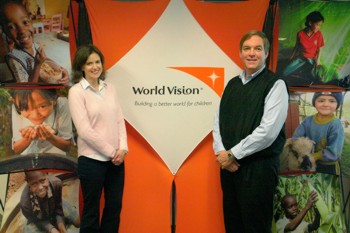World Vision Plays Large Role in Haitian Relief - Past, Present, and Future
World Vision Plays Large Role in Haitian Relief - Past, Present, and Future
Although it may not be as well known as some other aid organizations, World Vision, a Christian humanitarian charity based in Washington state, serves close to 100 million people through operations in nearly 100 countries. The organization was started in the early 1950s as a sponsorship program for children orphaned during the Korean War. It has since taken on a much larger role, tackling the causes of poverty and injustice worldwide. It also orchestrates global relief efforts in the wake of disaster, whether the result of earthquake, hurricane, famine, civil war, exploitation, or disease.
As to be expected, World Vision is in high gear in Haiti following the devastating January 12 earthquake. The three local staffers who work out of the organization's northern California office in Hacienda are proud of their connection to this life-saving mission.
World Vision's presence in Haiti goes back 30 years, explains Andy Smith, who serves as a church adviser for northern California. When the quake hit, a staff of 370 was already on the ground. The relief effort brought in 400 more.
"We had warehouses stocked full of emergency supplies for a hurricane that never happened, so at the time of the quake we were in-country and ready to go," Smith relates.
It has been slow going, admits Deborah Padberg, the west team administrator, also based in Hacienda. The combination of an already sub-standard infrastructure and the destruction of Port au Prince, the country's capital city and hub, have been a major deterrent to distributing supplies.
Still, the obstacles have not kept World Vision teams, many of them composed of indigenous specialists with valuable technical expertise, from their good works. One priority has been setting up half a dozen child-friendly spaces that welcome children without caretakers, offering them safety, food, shelter, and clothing, along with counseling to help them deal with trauma. The charity is also currently providing food for about 25 percent of the country's population, Padberg adds.
World Vision has received an outpouring of support for its Haitian relief efforts from all kinds of donors- churches, corporations, individuals. Volunteers are eager to travel onsite and participate in the physical recovery, but it's still too early, Padberg points out. The actual relief ministry unfolds in three stages: rescue and survival-saving lives, cleaning up, and assessing needs; then relief - setting up tent villages, distributing medical kits and hygiene supplies; and, finally, rebuilding, a process that will take many years.
"We are still in the first stage," she notes. "The message to all the churches and individuals who want to go there to help is 'wait.' The greatest need right now is money to get resources to the professionals on the ground, so they can do their work."
In the long-term, the charity anticipates raising and spending approximately $350 million for recovery and renewal assistance. "Even as Haiti fades from the headlines, the needs are great. We expect to be there another 30 years," says Smith. For more information on World Vision's full range of programs, visit www.worldvision.org.
Photo: Deborah Padberg, left, and Andy Smith of World Vision.
Also in this issue...
- New Ellie Mae Acquisition Helps Mortgage Lenders Streamline Compliance
- Pyramid Screening Introduces Gen-2 Jobs Board, BulletHire.com
- Business Bits
- Executive Profile: Andrew Maxwell, Heart of the Valley Pediatric Cardiology
- BKF Engineers 'Very Strong and Growing'
- World Vision Plays Large Role in Haitian Relief - Past, Present and Future
- Local & Regional Educational Resources
- April 26 Bogey Bash Golf Tournament Raises Funds for Arc of Alameda County
- 511 Rideshare: A Commute Calculation That Adds Up
- 'SHAKE 2010' Earthquake Exercise Comes to Hacienda the Week of April 26
- New 511 RideMatch Service
- Save the Date! A Taste of Summer
- Hacienda Index
- Calendar





